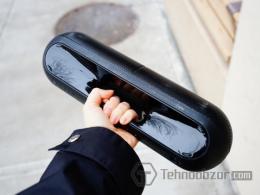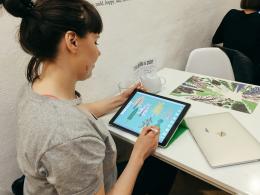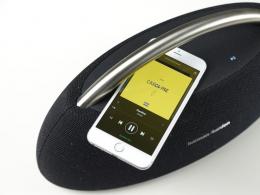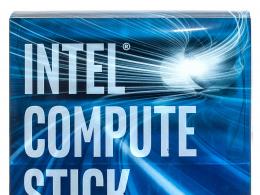Presentation on the topic "classification of computers". Classification of computers by functionality
http://www.mkgt.ru/files/material-static/138/contents.htm
PCs and workstations
Servers
Mainframes
Cluster architectures
To software terminology
Program
Software
Software tool
Software package
A program is a complete product that can be run by its author on the system on which it was developed.
Software - a program that anyone can run, test, fix and develop. Such a program should be written in a generic style, thoroughly tested, and accompanied by detailed documentation.
Such definitions are located, for example, at http://mf.grsu.by/Kafedry/kaf001/academic_process/048/28
SUMMARY OF THE REVIEW LECTURE. For students of the specialty
T1002 " Software information technologies» (A.M.Kadan, Ph.D., Associate Professor)
Software Tool is a program or a logically related set of programs on data carriers, provided with program documentation.
Software package - a set of interacting programs, coordinated in functions and formats, precisely defined interfaces, and together they make up a complete tool for solving large problems.
GOST 19781-90 SOFTWARE FOR INFORMATION PROCESSING SYSTEMS Terms and definitions
Software of data processing systems. Terms and definitions
Program (Program) - data intended to control specific components of the information processing system in order to implement a specific algorithm
Program (en program): - see GOST 19781.
Software product (en software product: Software intended to be delivered,
transfer, sale to the user.
GOST 28806-90 SOFTWARE QUALITY Terms and definitions
software quality. Terms and definitions
software tool; PS (en software):
An entity consisting of programs, procedures, rules, and, where applicable, associated documentation and data relating to the operation of an information processing system.
Note. A software tool is specific information that objectively exists as a set of all properties of each of the material objects that are significant from the point of view of its presentation, containing this information in a fixed form.
Glossary (glossary.ru)
Software product- a program or a logically related set of programs:
- recorded on data carriers;
- being a product of industrial production;
- supplied with program documentation;
Intended for wide distribution through sale or through freeware, shareware, or OEM methods.
Software package- a set of interacting programs:
- agreed on functions and formats;
- having uniform, well-defined interfaces; constituting a complete tool for solving large problems.
Computers can be classified according to different criteria, for example, by size, by application, by speed, by functions performed, by stages of their creation, etc. In this presentation, we will consider a classification according to a generalized criterion, where several characteristic features:




Parameters Large computers Small computers Performance (million ops / s) 1000 – RAM size (MB) Size external memory(GB) , Bit depth (bit) 64; 12816; 32; 64


SERVERS A SERVER is a powerful computer used in computer networks, which provides maintenance of computers connected to it and access to other networks. The server stores large amounts of information that other computers connected to it use. The server is subject to increased requirements for speed and reliability. It should provide for the possibility of backing up all stored information. Preventive and repair work should be carried out without stopping it and turning off other computers.












CHARACTERISTICS "Friendliness" of the human-computer interaction interface Low cost Small dimensions Open architecture A large number of software tools for various applications Compatibility of new versions and models High reliability of work

Generalized characteristics personal computers Parameters Type of microprocessor PentiumPentium Pro Clock frequency(MHz) 60 - - 600 RAM (MB) 8, 16, 32 16, 32, 64, 128 hard drive(GB) 1 - 102 - 16 Cache size (KB) 512, 1024, 2048 Bit depth (bits) 32
 PORTABLE COMPUTER The name comes from the Latin porto - "carry" and means that they are easy to carry from place to place. Their weight ranges from 0.2 to 6 kg. Usually they are designed in the form of suitcases or folders and, in turn, are divided into several types: 1.laptop 2.organizer - electronic Notebook
PORTABLE COMPUTER The name comes from the Latin porto - "carry" and means that they are easy to carry from place to place. Their weight ranges from 0.2 to 6 kg. Usually they are designed in the form of suitcases or folders and, in turn, are divided into several types: 1.laptop 2.organizer - electronic Notebook

 Are intended for use in production conditions. Embedded in technological process production of any products, manage production lines and machines. With their help, they control planes, trains, conduct research and test new instruments, mechanisms, and devices. They are subject to increased requirements for reliability, resistance to various fluctuations in environmental parameters (temperature, vibration, dust, etc.)
Are intended for use in production conditions. Embedded in technological process production of any products, manage production lines and machines. With their help, they control planes, trains, conduct research and test new instruments, mechanisms, and devices. They are subject to increased requirements for reliability, resistance to various fluctuations in environmental parameters (temperature, vibration, dust, etc.)

test questions and tasks 1. Describe the class of personal computers. 2. Give the main characteristics of a personal computer. 3. What characteristics of a portable computer are essential for a user and why? 4.What affects the price of a computer the most? 5. What are the characteristics of portable computers do you know? 6.Tell us about the purpose of organizers and notebooks. 7. How do you imagine an industrial computer?

Publication date: 11.07.2016
Short description:

CLASSIFICATION OF COMPUTER DEVICES Prepared by: teacher of computer science and ICT MBOU secondary school No. 37 Krasnodar Solodukhina E.A.

Input Devices Keyboard Pointing Mouse Trackball Touchpad Graphics tablet Joysticks Digital and Webcam Scanner


Storage devices Floppy disk Discs (CD-R, CD-RW, DVD-R, DVD-RW) Volatile memory cards Flash card


Computer Monitor Peripherals Printer Scanner Modem Webcam System unit Motherboard RAM HDD HDD Sound card Network Card video card CPU Power supply Cooling system Control devices Mouse Keyboard Joystick

The system unit, the main part of the computer, where everything happens computing processes. The system unit is quite complex and consists of various components.

The main input device of the majority computer systems is the keyboard. The keyboard in one form or another is likely to remain the main input device, even despite the development of speech recognition technologies. The keyboard is a set of mechanical sensors that perceive pressure on the keys and close in one way or another a certain electrical circuit. The basic principle of the keyboard is to scan the key switches, and the closing or opening of any of them corresponds to its own unique digital code.

Modern keyboards have 101 to 105 keys for various purposes: Alphanumeric or sign keys for entering letters of the English and national alphabets, as well as numbers and various symbols, Utility keys (Enter, Tab, Esc, Insert, Delete and others) for performing certain actions, for example, to finish entering text, delete character, etc., Cursor keys (Home, End, PageUp, PageDown), Control keys (Shift, Ctrl, Alt), pressed in combination with other keys and changing their value, Function keys (from F1 to F12), used to access to certain functions in various programs, Keypad used for fast entry numbers and mathematical operations. Cursor keys


In the optical-mechanical mouse manipulator, the main working body is a massive ball (metal, covered with rubber), the rotation of which is converted into the movement of the mouse pointer on the monitor screen. At present, widespread optical mice, in which a light source placed inside the mouse illuminates the surface, and the reflected light is captured and converted to the movement of the mouse pointer on the screen. The mouse usually has two control buttons, which are used when working with GUI programs. Currently, mice have appeared with an additional wheel, which is located between the buttons. It is designed to scroll up or down images and texts that do not fit entirely on the screen.

A trackball is not much different from a mouse. In essence, it is the same mouse, but turned upside down, more precisely, turned upside down with a ball. If you need to move the mouse around the table and, while rolling the ball, control the movement of the marker on the screen, then in the trackball you just need to twist the ball itself in different directions with your fingers or palm. In laptop computers, the trackball is often built right next to the keyboard, or clipped onto the side or front of the computer keyboard. However, keyboards with a built-in trackball are also available for desktop computers. And in the most portable computers, instead of a mouse and a trackball, they now use a tiny pointer - a small colored pin sticking out among the keys on the keyboard, which, like a joystick, can be pressed in different directions.

The touch panel is a surface that can recognize touches on it. A controller is supplied with the surface, which converts them into a digital signal regular computer. The uniqueness of the touch panel idea allows you to install the device in three steps: Overlaying the touch panel on a regular monitor, Connecting the controller connected to the touch glass to the computer, Installing the driver for operating system. But most often touch panels are used on portable computers. With convenience, reliability and a variety of applications, sensor technologies help people in everyday life: work, study and leisure. This technology is intended for both advanced users and people who are unfamiliar with computer technology. Entering information by touch is simple and natural, so working with touch screen does not require training. intuitive understandable system communication eliminates the occurrence of errors, and the instantaneous response of the impact on the touch screen in some cases is the determining factor in the choice of equipment.

At present, the infrared touch panel is widely used. Advantages of infrared technology: Durability. All components (line of light and photodiodes) are located in the display frame. Unlike resistive and capacitive technologies, IR touch displays do not use fragile translucent touch coatings. Scratches, dirt, and even cracks do not affect the functionality of the touchpad. No calibration required. Calibration stability is based on 100% digital positioning. It is controlled by any opaque object - a pencil, a gloved hand. Quality image. No conductive coatings on glass.

Joystick - an information input device made in the form of a control handle, shaped like a car speed switch or an airplane steering wheel. The joystick is mainly used for computer games.

Another input device graphic information in a computer is an optical scanning device, commonly referred to as a scanner. The scanner is the eyes of the computer. Initially, they were created specifically for entering graphic images, drawings, photographs, drawings, diagrams, graphs, diagrams. The quality of the scanned image obtained depends on the type of scanner. However, in addition to graphics input, they are now increasingly used in fairly complex intelligent OCD or Optical Character Recognition systems, that is, optical character recognition. These smart systems allow you to enter into the computer and read the text. Scanners come in various designs: Handheld, Flatbed, Drum, Projection.

Monitor is universal device information output. Desktop computers usually use cathode ray tube monitors, which can be a source of radiation harmful to humans. Modern monitors comply with strict sanitary and hygienic requirements and do not adversely affect human health.

In portable and handheld computers, flat-panel monitors on liquid crystals are used. Recently, such monitors have been used in desktop computers. The advantage of liquid crystal monitors is their compactness and the absence of radiation. Information on the monitor screen is presented as a raster image, which is formed from individual dots (pixels). A raster image consists of a certain number of lines, which in turn contain a certain number of points.

Printers are designed to output to paper (create a hard copy) of numerical, textual and graphic information. According to the principle of operation, printers are divided into: Dot-matrix, Inkjet, Laser.


The hard disk is for long-term storage information, it contains the programs necessary for the operation of the computer (Windows, Office, Internet Explorer.) and user files (Mail files, if used mail client, video, music, pictures.).

A video card is a board inside the system unit, designed to connect the system unit and the monitor, transmits the image to the monitor and takes over part of the calculations for preparing the image for the monitor. Image quality depends on the video card. The video card has its own built-in RAM and your image processor. The higher the frequency of the processor of the video card and the more memory of the video card, the more cool (later released) games you can play on your computer.

Sound card - designed for preparation sound signals played back by speakers. The sound card is usually built into motherboard, but it can also be structurally separated and connected via a bus.

A network card is a board, a device that is installed in the motherboard or built into it. A network card is used to connect a computer to other computers via local network or to connect to the Internet.

CD / DVD-ROM - a device for reading / writing CDs, CDs, DVDs. These devices differ in the speed of reading or writing information, as well as the ability to read / write various media. It's hard to find anything other than omnivorous CD-ROMs on the market these days. Modern CD-ROMs are capable of reading and writing both CDs and DVDs of various capacities.
Presentation "Classification modern computers"made in MS PowerPoint 2003 and allows you to systematize knowledge about the currently used terms to refer to the varieties of modern computers. All terms are given with explanations and each term (name) is associated with an image.
Download:
Preview:
To use the preview of presentations, create an account for yourself ( account) Google and sign in: https://accounts.google.com
Slides captions:
Classification of modern computers Developed by: computer science teacher Isupov S. L. Izhevsk 2014 Ministry of Education and Science of the Udmurt Republic MBOU "Secondary School No. 59"
Personal computers Servers Supercomputers
Desktops Portable Subnotebooks Notebooks Netbooks Ultrabooks Tablets Desktops Nettops Monoblocks Smartbooks
Desktop A desktop computer is a stationary personal computer designed to work in an office or at home.
Nettop Nettop (English nettop) - a small desktop PC in size of its system unit. The term ″Nettop″ is derived from ″InterNET″ and ″deskTOP″. It is used in conjunction with the server and when using ″cloud″ technologies.
Monoblock Monoblock (Greek μονος - one) - combines a monitor and system unit in one case, it is used to reduce the area occupied by the equipment and give a more aesthetic appearance.
Notebook Notebook (English notebook - notepad) or laptop (English lap - knees, top - top) - a portable personal computer, in the case of which the display, keyboard and pointing device (usually a touch panel, or touchpad), as well as batteries are combined .
Netbook Netbook (eng. Netbook, net - network, book - book) - a laptop with relatively low performance, designed mainly for accessing the Internet. It has a small screen size of 7-12 inches, low power consumption, light weight and relatively low cost.
Subnotebook A subnotebook, or ultraportable laptop, is small and light and has most of the features of a regular laptop.
Ultrabook An ultrabook is an ultra-thin and light subnotebook that is even smaller and lighter than a regular laptop, but with most of the characteristics of a full-fledged laptop.
Smartbook Smartbook (eng. Smartbook from smart phone - smart phone and note book - notepad) or PDA (Pocket PC) - a small laptop built on a hardware platform of the same class that is used for smartphones and tablet computers.
Tablet Tablet computer (eng. Tablet computer or electronic tablet) is a collective concept that includes various types mobile devices with touch screen. tablet computer can be controlled with the touch of a hand or stylus.
Server A server is a computer allocated from a group of personal computers to perform a service task without direct human participation. Distinguish server working group, domain controller server, web server, e-mail server, file server, etc.
Supercomputer Modern supercomputers are a large number of high-performance server computers connected to each other by a local high-speed backbone to achieve maximum performance. Lomonosov supercomputer built by T-Platforms for Moscow State University named after M.V. Lomonosov.
In addition to the above, there are also various hybrid devices.
On the topic: methodological developments, presentations and notes
Classification of modern educational technologies
1. On the issue of defining the concepts of "teaching technology", "method of teaching", "form of teaching", "pedagogical technique", etc. 2. To the problem of classification of "methods" and "forms" of teaching. 3. Specific...
Computer classification
Topic: "Classification of computers by functionality»Program section: Hardware information technology Type of lesson: learning new material Objectives: 1. ...






